Imperial Airways
To try and get away from trawlers, to see the world from ocean-going ships, in 1935 Allen Finch (AF) enrolled at Hull Municipal Technical College, full time, to get his Advanced Radio Operators Licence.
He had also heard that an air operators licence
was also available.
He took the exams at the GPO in London, and went down to Croydon airport to see what all this flying stuff was about
.
He applied to Imperial Airways by telegram from a trawler off Murmansk, was asked to come for an interview, and on 23rd March 1936 reported to Imperial Airways at Croydon Airport.
The interview was a cup of tea with the manager, Air Vice Marshall Sir Tom Webb-Bowen, and the 'training course' consisted of being being shown around a de Havilland DH 86 in the hanger.
Radio officers were important for both communication and navigation. All communication was by radio telegraphy using morse code, and it was essential to have a separate morse code operator.
Standard Q codes meant that communications were independent of spoken language - it didn't matter if you spoke English, French or Hungarian, or had a strong Scottish accent.
An observer with a radio would be stationed on the perimeter of the airfield.
An approaching aircfraft would wait untill they received the Q code from the observer for plane over head, I can hear you
.
The plane would then send the Q code for may I land
.
The observer would send you may land
.
And the Radio Officer would tell the pilot to land...
The special code 'ZZ' meant put the nose down and you should see the landing area straight ahead.
Flying the aircraft obviously needed close liason between the pilot and radio officer, who might be seated next to the pilot, operating the radio by cables, or behind the pilot.
Log Books
A log book entry had to be recorded for every flight, and Alan Finch kept all 12 of his log books.
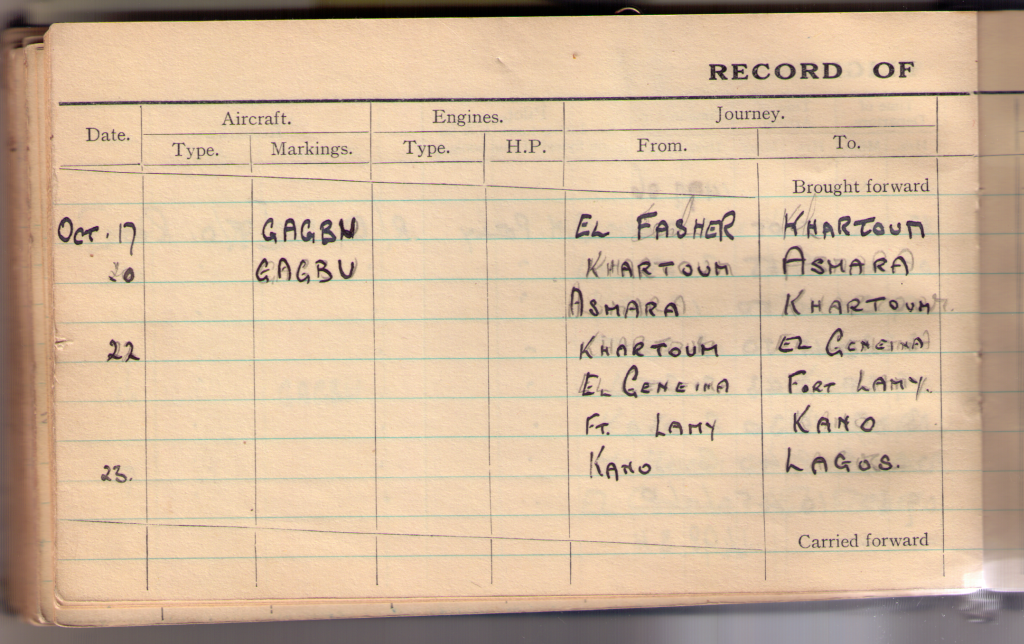
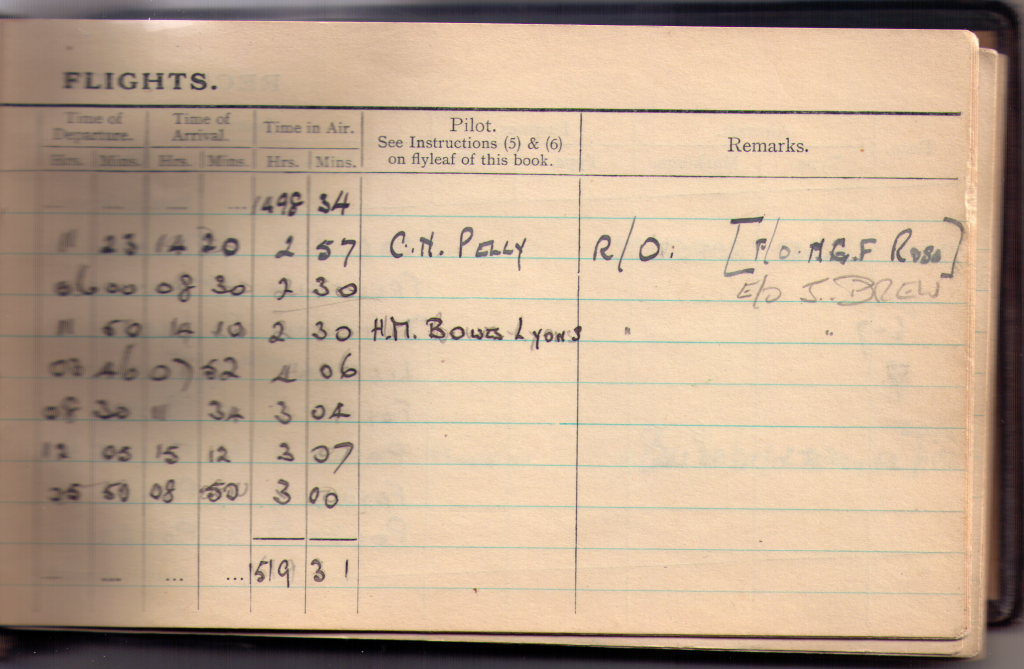 Entry for 17 Oct 1941 - G-AGBU was a Lockheed L18 Lodestar, the pilot was C N Pelly, but who was H.M. Bowes Lyon ?
Entry for 17 Oct 1941 - G-AGBU was a Lockheed L18 Lodestar, the pilot was C N Pelly, but who was H.M. Bowes Lyon ?
These notes are from Alan Finch's log books
UK Civil Aviation in the 1930's
Croydon was not a very popular place with pilots during periods of bad weather. It was said that the best way to get in was to go over the top, steer north easterly for a few minutes until you could smell the Waddon gas works, do a left hand turn, put the nose down and when you smelt the scent factory, you were there.
At this time UK civil aviation was very primitive compared to other countries. For example KLM and Lufthansa were already operating all-metal mono-planes, such as the Douglas DC3 and F???, while the biggest UK aircraft was the HP42 biplane, made of wood and covered in canvas.
Croydon, the main UK airfield, had grass runways, compared with Templehof Airport in Berlin that could accomdate
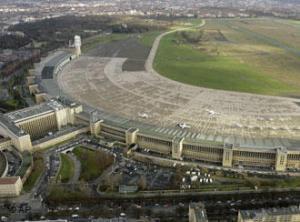

HP42 Hannibal on Croydon apron

Booking Hall

HP42 Hannibal over Croydon
March -> December, 1936 Imperial Airways
In December 1936 left Imperial and joined BA (Mk I)
Last flight with Imperial Airways was on 1 Dec 1936 in HP42 G-AAXC Heracles Croydon-Paris-Croydon with O.P. Jones (pilot) (!!)
British Airways (Mk I)
After AF was involved in trying to start a start a Radio Officers Trade Union, in December 1936 he left Imperial Airways and joined Britsh Airways.
BA was based at Gatwick, with routes to Paris, Lille, Malmo, Hamburg, Copenhagen.
29 Dec 1936 G-ADIM Gatwick-Lille return in same day, G.Rose (pilot)
In March 1937 BA moved back to Croydon, and then to Heston in May 1938
BOAC
In 1939, the UK government amalgamated Imperial Airways and British Airways to form British Overseas Airways Corporation (BOAC) - a state airline.
On August 1939 BOAC assumed responsibility for the general administration of the Air Transport Auxiliary (ATA)
The ATA delivered 308,567 aircraft of 147 types between 1940 and 14, and ceased to function as a ferry organisation on 30 November 1945.
In 1946, British European Airways (BEA) was hived off to run Europen services, leaving BOAC with long-haul (non European) services.
Allen Finch remained with BOAC until 1958, when Radio Officers were made redundant.
Summary
Summary Chronlogy, showing main aircraft
| Year | Date | Aircraft | Routes |
|---|---|---|---|
| 1936 | 23 Mar |
De Havilland DH86
Handley-Page HP42 Shorts L17 Scylla Vickers Viastra Westland Wessex Boulton & Paul P71A |
Imperial Airways
Croydon-Zurich, Paris, Budapest, Martlesham, Kõln , Basle (Switzerland) , Brindisi , Beroke, Brussels Le Touquet Rome Marseilles Leipzig Hassalt (emergency) |
| 14 Dec |
De Havilland DH89
De Havilland DH86 Lockheed LH10a |
British Airways (MkI)
Gatwick-Lille, Malmo, Hamburg, Copenhagen, Amsterdam |
|
| 1937 | 5 Dec | (BA moves to Croydon) | |
| 1938 | 19 May | (BA moves to Heston) | |
| 1938 | 21 Sep | Fokker XII G-AEOS Heston-Basle-Paris-Heston | |
| 1938 | 26 Oct |
Lockheed L14
e.g. G-AFGN |
Heston-Lisbon-Seville-Salamanca-Heston |
| 1938 | 19 Nov | Heston-Bordeaux-Southhampton-Heston | |
| 1939 | 24 Mar | Heston-Lisbon, Stokholm, Budapest, Zurich, Warsaw | |
| 1939 | 18 Jul | Oxford G-AFFM Heston-Elsmsdon, Speke, Ringway | |
| 1940 | 6 Mar |
AW27 Ensign
e.g. G-ADSS |
Heston-Paris
Heston-Paris |
| 1940 | 1 Apr |
Lockheed L14a
De Havilland DH86 |
Heston-Bordeaux, Marseilles, Tunis, Malta, Alexandria, Sollum |
| 1940 | 18 Jun |
Lockheed LH14
e.g. G-AFKE |
Heston-Oporto, Oran, Namy, Kano, Fort Lamy, Cairo, Accra, Lagos, Khartoum
No return to Heston |
| 1941 | 16 March | Capetown, Port Elizabeth, Durban, Bulawayo, Kasana, Kisumu , Lorenco Marques, Salisbury, Lusake, Dodoma, Nairobu , Entebbe, Stanleyville, Libreville, Lagos | |
| 1941 | 5 Dec |
S30 C Class
e.g. G-AFCT Champion Catalina PBY5 G-AGDA G-AGFM S25 Sunderland e.g. ML725 S26 G Class G-AFCI Golden Hind |
Lagos-Freetown-Bathurst-Lisbon-Foynes-Poole
Hythe-Poole-Foynes-Lisbon-Gibralter-Malta-Cairo--Poole |
| 1942 | |||
| 1943 | |||
| 1944 | Feb 17 | S25 G-AGET | Poole-Foynes-Poole-Gibralter-Jerba-CairoHabinyeh-Bahrein-Karachi-Cairo-Jerba-Gibralter-Poole |
| 1944 | Dec |
Lancastrian
Dakota York Viking |
Ossington (UK) Rabat (Morocco) Stockholm (Sweden) Copenhagen (Denmark) Gibralter (UK possession) |
| 1945 | |||
| 1946 | Oct |
Liberator
L039 Constellation |
Montreal<=>LAP and Bermuda, New York via
Prestwick (Scotland) Keflavick (Iceland) Shannon (Ireland) Santa Maria (Azores) Sydney (Nova Scotia, Canada) |
| 1947 | |||
| 1948 | |||
| 1949 | Dec | Boeing B377 Stratocruiser | LHR<=>NewYork, Bermuda via
Keflavik (Iceland) Gander (Labrador) Prestwick (Scotland) Shannon (Ireland) 8 Feb 1956 Anthony Eden (prime minister) from Ottawa. Feb 1957: two trips to West Africa LAP-Rome-Kano-Lagos,Accra,Kano,Rome,LAP in G-ALB?D |
| 1950 | |||
| 1951 | |||
| 1952 | |||
| 1953 | |||
| 1954 | |||
| 1955 | |||
| 1956 | |||
| 1957 | |||
| 1958 | 8 Nov | B377 G-AGKI Caribou | NY=>LHR non-stop in 12:15 Pilot: SIMCO
finito |
Total flying hours 12,123 hrs 40min
de Havilland DH 86 Express

Caption
The De Havilland DH 86 Express was a 4 engine bi-plane, with 2 pilots plus wireless operator, and 8-12 passengers.
Designed by De Havilland in 1933 for the Empire mail routes, it was ordered by Imperial Airways, QANTAS. and other Australian operators.
QANTAS used it for the Singapore-Brisbane-Sydney-Hobart legs, and Imperial used it in Europe and also to Khartoum and Lagos.
The first four production planes had space for a single pilot, but this was changed to 2 pilots side-by-side in the DH86B model.
AF says that the left seat was used by the radio officer, with
three motorcycle type Bowden cable levers mounted on the window frame leading back to the radio mounted behind them,
So the poor operator couldn't even see his set!
The Radio Officer also did navigation from bearings obtained from ground radio stations, and also had to log engine behavious.
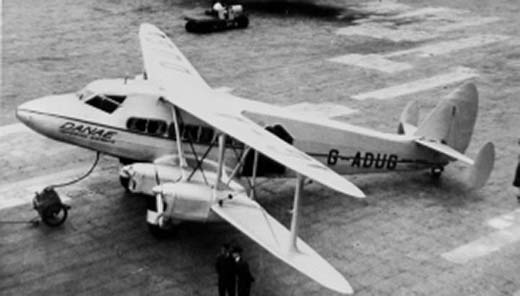
Caption
After three fatal DH86 accidents in Australia, the Australian Government suspended the DH86 Certificate of Airworthiness, causing outrage in Britain as it reflected on the whole British aircraft industry.
But the DH86 had approached the limits of 'plywood and canvas' aircraft construction and was obsolete compared to all-aluminium aircraft like the DC3. In 1936 the Australian Government rescinded its ban on the import of American aircraft, and for the next 25 years most large commercial aircraft imported into Australia were American.
AF first flew in a DH86 G-ADUG on 21 Apr 1936 from Croydon -> Zurich, return the next day, E.R.B White as pilot.
Typical flights and times...
| Croydon | Zurich | 4 hrs |
| Zurich | Paris | 3 hrs |
| Paris | Croydon | 2 hrs |
De Havilland DH 89 Dragon Rapide
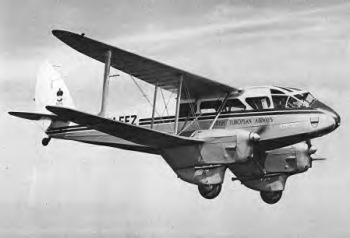
???
The DH 89 Dragon Rapide was a short-haul, twin engine bi-plane, first flown April 1934. Designed as a faster and more comfortable successor to the DH.84 Dragon carrying 8 passengers, but without the operational problems.
It went on to become perhaps the most successful British-built commercial passenger aircraft of the 1930s.
AF left Imperial Airways and joined British Airways (Mk I) in December 1936, and his first flight with BA was in a DH89 G-XXX on 29 Dec Gatwick-Lille
Handley Page HP 42
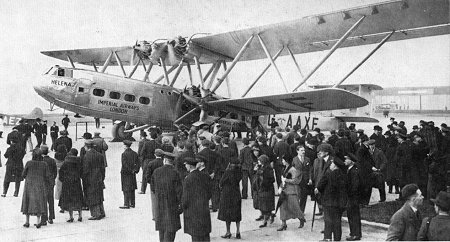
Helen (G-AAUC) was was one of four HP45 Western models.
A large unequal-span biplane of all-metal construction except for the fabric coverings of the wings, tail surfaces and rear fuselage. 38 passengers, 4 engines, 100 mph cruise, span 130 feet, length 90 feet
Imperial Airways had 8 HP42's, although four were actually the HP45 model for Western (European) service.
No lives were lost in civilian service with the HP 42, but by 1940 all had been destroyed.
| HP 42 (Eastern type) | ||
|---|---|---|
| G-AAGX | Hannibal | Crashed in Pesian Gulf 1 Mar 1940 |
| G-AAUC | Horsa | Burnt out, Port Morseby 7 Aug 1940 |
| G-AAUD | Hanno | Wrecked in gale, Whitchurch, 19 Mar 1940 |
| G-AAUE | Hadrian | Wrecked in gale, Doncaster, 6 Dec 1940 |
| HP 45 (Western Type - European) | ||
| G-AAXC | Heracles | Wrecked in gale, Whitchurch, 19 Mar 1940 |
| G-AAXD | Horatius | Crashed Tiverton 7 Nov 1939 |
| G-AAXE | Hengist | Burnt out, Karachi, 31 May 1937 |
| G-AAXF | Helena | Scrapped 1941 |
AF first flew in an HP 45 on 27 April 1936 on G-AAXD Horatius Croydon-Paris - overnight in Paris and return the next day, with H.S.Horsey as pilot.
Short L 17
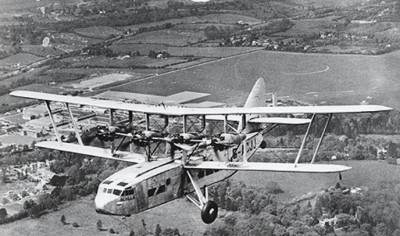
Short L17 Scylla
The Short L.17 Scylla was a British 4-engined 39-seat biplane luxury airliner designed and built by Short Brothers at the request of Imperial Airways and used by them for scheduled flights between London and European cities e.g. Paris.
Only two aircraft were built, the Scylla (G-ACJJ) and the Syrinx (G-ACJK) - WikiPedia.
AF first flew in G-ACJJ Scylla on 30 April 1936 Croydon-Brussels - overnight in Brussels and return the next day, with A.B.Youell as pilot.
Vickers Vellox
not sure about this
Crew: 3
Passengers: 10
G-ABKY
Vickers Viastra
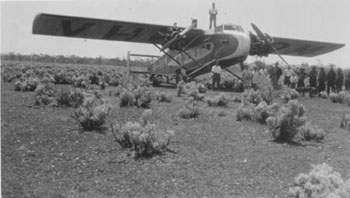
metal, high-wing monoplane
G-ACCC is Vickers (aviation) Ltd VICKERS 259 VIASTRA MKX
The first prototype flew on 1 October 1930 powered by 3 x 201kW Armstrong Siddeley Lynx Major. Two production Viastra IIs were powered by two 391kW Bristol Jupiter XIFs and one Viastra VI - by one Jupiter XIF.
Ho wmany Which model wa sthisat was this ? How mnay did Imperial Airways have ?
AF first flew in G-ACCC Viastra on 19 May 1936 Croydon-Martlesham, and the next day Croydon-Köoln-Croydon. depart ??:?? arrive back at Croydon 21:55 with pilot J Oliver.
Westland Wessex
Pic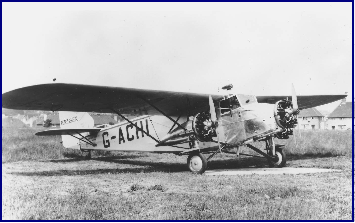 High wing, mono-plab=ne, metal 6 ? passengers ??
The six-seat Westland IV light transport of 1928 was a braced high-wing monoplane, powered originally by three 95 hp (71 kW) ADC Cirrus Mk III inline engines and accommodating a crew of two in an enclosed flight deck with a separate four passenger cabin. First flown on 22nd February 1929, it was followed by a second aircraft with 105 hp (78 kW) ADC Cirrus Hermes I engines. The construction of two more aircraft had started, but these were completed instead with three 105 hp (78 kW) Armstrong Siddeley Genet Major I radial engines and given the name Wessex, the two Westland IVs then being converted to this standard. Six more examples of the Wessex were built, the last four each having a metal-skinned forward fuselage and more powerful Genet Major IA engines; one of them, for service with Portsmouth, Southsea and Isle of Wight Aviation, had reduced baggage space to allow for the carriage of six passengers. These aircraft proved reliable and most were in service for a number of years; the last two, operated by Air Pilots Training at Hamble, were finally withdrawn from use in 1940. With a wing span of 57 ft 6 in (17.53 m), late versions of the Wessex had a maximum speed of 122 mph (196 km/h).
High wing, mono-plab=ne, metal 6 ? passengers ??
The six-seat Westland IV light transport of 1928 was a braced high-wing monoplane, powered originally by three 95 hp (71 kW) ADC Cirrus Mk III inline engines and accommodating a crew of two in an enclosed flight deck with a separate four passenger cabin. First flown on 22nd February 1929, it was followed by a second aircraft with 105 hp (78 kW) ADC Cirrus Hermes I engines. The construction of two more aircraft had started, but these were completed instead with three 105 hp (78 kW) Armstrong Siddeley Genet Major I radial engines and given the name Wessex, the two Westland IVs then being converted to this standard. Six more examples of the Wessex were built, the last four each having a metal-skinned forward fuselage and more powerful Genet Major IA engines; one of them, for service with Portsmouth, Southsea and Isle of Wight Aviation, had reduced baggage space to allow for the carriage of six passengers. These aircraft proved reliable and most were in service for a number of years; the last two, operated by Air Pilots Training at Hamble, were finally withdrawn from use in 1940. With a wing span of 57 ft 6 in (17.53 m), late versions of the Wessex had a maximum speed of 122 mph (196 km/h).
| - | G-AAGW | - | 1929 | Sold 1936 |
| - | G-ABEG | - | 1933 | Crashed 1936 |
| - | G-ACHI | - | 1933 | Sold 1936 |
G-AAGW
AF first flew in G-AAGW ???Wessex on 9 Jun 1936 on a tets fst flight from Croydon, pilot: Travers., and 5 hrs again n 18 Jun 1936
Boulton & Paul P71A
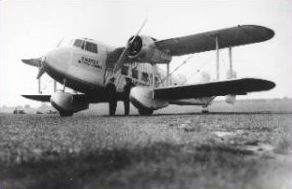
The P71 was a British twin-engined all-metal biplane transport aircraft developed by Boulton & Paul in 1935 to meet an Imperial Airways requirement for a mailplane.
Two aircraft were built - G-ACOX Boadicea and G-ACOY Britomart. Imperial lost interest in using them as mailplanes and they were converted as VIP transports with 13 removable seats.
AF first flew in G-ACOX Boadicea on 17 Jul 1936 Croydon-Bereroke and return, with E.R.B. White as pilot.
G-ACOX Boadicea was lost in the English Channel on 25 September 1936 with the loss of the two crew.
G-ACOY Britomart was damaged beyond repair in a landing accident at Haren, Brussels on 25 October 1935.
See more information.
Lockheed L10 Electra

Lockheed 10 Electra
The Lockheed 10A was a twin engine, all metal, 8 passengers and ?? crew
Amelia Earhart was flying a modified Electra when she disappeared in July 1937.
AF first flew on a Lockheed 10A on 14 May 1939, Croydon-Paris return
Lockheed 10A Electra
| Markings | Notes |
|---|---|
| G-AEDS | ??? |
| G-AEMY | |
| G-AEPN | Destroyed 6.11.40 |
| G-AEPO | scrapped 6.46 |
| G-AEPP | Crashed Croydon 13.12.37 |
| G-AEPR | Crashed Almaza Egypt 14.4.44 (21 Oct 1939 heston/Paris) |
| G-AESY | Crashed into sea 15.8.39 |
| G-AFCS | Crashed Almaza Egypt 19.11.43 |
| G-AFEB | Dbr Clifton 12.10.41 |
Lockheed L14
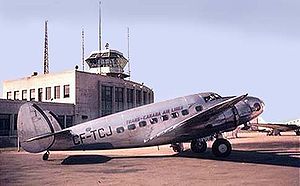
caption
Lockheed 14, twin engine, all metal
The Lockheed Model 14 Super Electra was a civil cargo and passenger aircraft built by the Lockheed Aircraft Corporation during the late 1930s. The design was a scaled-up version of the original Electra; the design team was lead by Don Palmer. The first Model 14 flew on July 29, 1937, piloted by Marshall Headle. Lockheed built a total of 114 Model 14s; Record-breaking flights In May 1938, a team of aviators of the Polish airline LOT, made up of Waclaw Makowski, director of the LOT and first pilot, Zbigniew Wysiekierski, second pilot, Szymon Piskorz, mechanic and radionavigator, Alfons Rzeczewski, radio-navigator and Jerzy Krassowski, assistant, accomplished an experimental flight from the United States to Poland. This flight was carried out on board one of the planes bought by LOT and manufactured by Lockheed in California, Lockheed L-14H Super Electra (of which the Polish registration was SP-LMK [1]). The crew took off from Burbank (Los Angeles) where these planes were manufactured, towards Warsaw. The distance covered was of 24,850 km. They flew over the states of Central America (Mazatlan, Mexico City, Guatemala, Panama), of South America (Lima, Santiago, Buenos Aires, Rio, Natal), the South Atlantic, Africa (Dakar, Casabianca, Tunis), Italy (Roma). The flight lasted 85 hours between May 13 and June 5. The overflight of the Atlantic - from Natal in Brazil to Dakar in Africa - lasted 11 hours and 10 minutes (3,070 km). This exploit of Polish aviators really marked the history of air communication on a world level. [2] Howard Hughes flew a Super Electra (NX18973) on a global circumnavigation flight. With four crewmates (Harry Connor, copilot and navigator; Tom Thurlow, navigator; Richard Stoddart, radio operator; and Ed Lund, flight engineer), the plane took off from Floyd Bennett Field in New York on July 10, 1938. The flight, which circled the narrower northern latitudes, passed through Paris, Moscow, Omsk, Yakutsk, Fairbanks, Alaska, and Minneapolis, before returning to New York on July 14. The total distance flown was 14,672 mi (23,612 km).Lockheed 14-WF62 Super Electra/BritishAirways/heston
| G-AFGN | Burnt out in forced landing Luxeuil France 11.8.39 (AF flew 29 Apr 1939 Heston/Warsaw) |
| G-AFGO | Crashed Walton 22.11.38 |
| G-AFGP | Crashed Khartoum Sudan 4.8.41 (Africa Apr 1940) |
| G-AFGR | Crashed El Fasher Sudan 19.1.41 (Africa Apr 1940) |
| G-AFKD | Crashed nr Loch Lomond 23.4.40 (AF flew 12 Jun 1939 Heston/Budapest) |
| G-AFKE | Impressed 19.11.43 (Africa) |
| G-AFMO | Crashed Heston 15.1.40 (AF flew 30 Jun 1939 Heston/Stokholm) |
| G-AFMR | Scrapped Kabrit Egypt 11.43 (AF first went to Africa in 1 Apr 1940 |
| G-AFYU | Crashed off Malta 21.12.39 |
| G-AFZZ | Crashed Bucharest 24.7.40 |
Airspeed AS.40 Oxford
| G-AFFM | Crashed and burnt after hitting balloon cables Gosport 20.11.39 (AF flew 18 Jul 1939 Heston/Bristol) |
Lockheed L18 Lodestar

Caption
The prototype of the Lockheed L-18, which first flew in 1939, was constructed from one of a batch of Lockheed L-14 Super Electras which had been returned to the manufacturer by Northwest Airlines after a series of crashes of L-14s.
The fuselage was lengthened by 5 feet (1.5 m), enabling the fitting of two more rows of seats and hopefully making the aircraft more economical to operate.
BOAC bought 9 of the 625 Lodestars of all variants that were were built.
Lockheed 18
| LOCKHEED 18-07 | |
|---|---|
| Lockheed Aircraft Corporation LOCKHEED 18 | |
| G-AGBO | Capetown local 26 mar 1941 |
| G-AGBP | registered to uk |
| G-AGBR | registered to uk |
| G-AGBS | registered to uk |
| G-AGBT | registered to uk |
| G-AGBU | 20 June 1941 Capetown/PortElizabeth |
| G-AJAW | registerd to uk |
| Lockheed Aircraft Corporation LOCKHEED 18-56 | |
| G-AGBV | Durban/Bulawayo |
| G-AGBW | Durban/Lorenco MArques/Khartoum/Kano |
| G-AGBX | registered to uk |
| G-AGCM | registered to uk |
| G-AGCN | registered to uk |
| G-AGCO | registered to uk |
| G-AGCP | registered to uk |
| G-AGCR | registered to uk |
| G-AGCU | registered to uk |
| G-AGCV | registered to uk |
| G-AGEH | registered to uk |
| G-AGEI | registered to uk |
| G-AGEJ | registered to uk |
| G-AGIG | registered to uk |
| G-AGIH | registered to uk |
| G-AGII | registered to uk |
| G-AGIJ | registered to uk |
| G-AGIK | registered to uk |
| G-AGIL | registered to uk |
| G-AGIM | registered to uk |
| G-AGIN | registered to uk |
| G-AGJH | registered to uk |
| G-AGLG | registered to uk |
| G-AGLI | registered to uk |
| G-BMEW | registered to uk |
Left UK in April, and on 23 Oct 1941 - flew to Lagos in G-AGBU to join BOAC West Africa service Flying Boats.
5 Dec 1941 flew in S30 G-AFCT Champion back to UK.
Fokker XII

Fokker XII 3 engine built for KLM service in Dutch East Indies in 1930
Wikipedia Wikipedia'...Of KLM's remaining F.XIIs, two went to British Airways in October 1936 who put them into service on night mail flights to Cologne and Hanover. One of the machines flew into a mountain on 19 November 1936, and the other was later acquired by British Overseas Airways in 1938. It was finally broken up in 1940'
Fokker F.XII| G-ADZH | British AW/ Croydon 23.03.36 6569 Sold Spain 8.36 |
| G-ADZI | Crilly Airways Ltd >British AW/ Croydon 31.01.36 6570 Crashed and dbf Biarritz on delivery flight 15.8.36 |
| G-ADZJ | Crilly Airways Ltd >British AW/ Croydon 29.01.36 6571 Sold Spain 8.36 Written off Leon 16.12.36 |
| G-ADZK | British AW/ Croydon 07.02.36 6572 Dbr La Rochelle France 16.8.36 |
| G-AEOS | British AW/Gatwick 29.10.36 7419 Scrapped 6.40 |
| G-AEOT | British AW/Gatwick 29.10.36 7420 Crashed nr Gatwick 19.11.36 |
AF first flight 21 Sep 1938 G-AEOS Fokker XII Heston-Basle-Paris-Heston, overnight in Paris, E.B. Filden (Pilot)
Aerial photograph of Heston wuith Fokker F VIII G-AEPU
Armstrong Whitworth AW27 Ensign
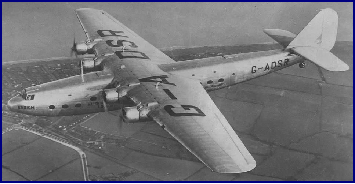
AW 27 G-ADSR Ensign
The AW27 Ensign an all-metal mono-plane intended for the Empire routes
The European model carried 40 passengers. The Empire variant ould carry 27 passengers in three cabins or, alternatively, sleeping berths for 20.

Passengers dismbarking G-ADSR Ensign
In Oct 1939 the fleet was evacuated to Bristol's Whitchurch airport along with a number of other airliners. Camouflage was applied, and the Ensign's operated a twice-daily service between Heston and Paris (Le Bourget).
| Markings | Name | Seats | Notes |
|---|---|---|---|
| G-ADSR | Ensign | 27 | |
| G-ADSU | Euterpe | 27 | damaged at Almaza |
| G-ADSX | Etterick | 40 | abandoned at Le Bourget, used by Germany |
| G-ADTA | Euralys | 27 | damaged at Lympne |
| G-ADSS | Egeria | 27 | |
| G-ADSV | Exolorer | 27 | |
| G-ADSY | Empyrean | 40 | |
| G-ADTB | Echo | 27 | |
| G-ADST | Elsinore | 27 | |
| G-ADSW | Eddystone | 40 | destroyed by enemy fire at Merville in 1940 |
| G-ADSZ | Elysian | 40 | destroyed by enemy fire at Merville in 1940 |
| G-ADTC | Endymion | destroyed Whitchurch in air raid, Nov 1940 | |
| G-ADZV | Enterprise | abandoned in West Africa 1942, salvaged by Vichy French used by Germany. | |
| G-ADZU | Everest |
AF first flew in G-ADSS Egeria on 6 Mar 1940 Heston-Paris return. This shuttle continued, twice a day, untill the end of March 1940, when he returned to Lockheed L14 to the Mediterranean
Shorts S23, S30, S33 C Class Empire Flying Boat
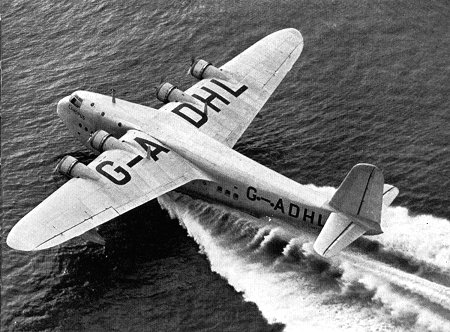
Shorts S23 C Class Empire Flying Boat G-ADHL CANOPUS
article
From http://www.bookrags.com/wiki/Short_Empire
| Registration | Name | Operator |
|---|---|---|
| S.23 | ||
| G-ADHL | Canopus | IA -> BOAC |
| G-ADHM | Caledonia | IA -> BOAC |
| G-ADUT | Centaurus | IA -> RAAF in 1939 (as A18-10) |
| G-ADUU | Caledonia | IA |
| G-ADUV | Cambria | IA -> BOAC |
| G-ADUW | Castor | IA -> BOAC |
| G-ADUX | Cassiopea | IA -> BOAC |
| G-ADUY | Capella | IA |
| G-ADUZ | Cygnus | IA |
| G-ADVA | Capricornus | IA |
| G-ADVB | Corsair | IA -> BOAC |
| G-ADVC | Courtier | IA |
| G-ADVD | Challenger | IA |
| G-ADVE | Centurion | IA |
| G-AETV | Coriolanus | IA -> BOAC -> QANTAS 1942 (as VH-ABG) |
| G-AETW | Calpurnia | IA |
| G-AETX | Ceres | IA->BOAC |
| G-AETY | Clio | IA->BOAC->RAF (1940 as AX659) |
| G-AETZ | Circe | IA->BOAC |
| G-AEUA | Calypso | IA->QANTAS (1939 not used directly)->RAAF (as A18-11) |
| G-AEUB | Camilla | IA->BOAC->QANTAS (as VH-ADU) |
| G-AEUC | Corinna | IA->BOAC |
| G-AEUD | Cordelia | IA->BOAC->RAF (1940 as AX660)->BOAC (1941 as G-AEUD) |
| G-AEUE | Cameronian | IA -> BOAC |
| G-AEUF | Corinthian | IA -> BOAC |
| G-AEUG | Coogee | IA->QANTAS (1938 as VH-ABC)->to RAAF (1939 as A18-12) |
| G-AEUH | Corio | IA->QANTAS (1938 as VH-ABD)->IA (1939 as G-AEUH) |
| G-AEUI | Coorong | IA->QANTAS (1938 as VH-ABE)->IA (1939 as G-AEUI) |
| G-AFBJ | Carpentaria | IA (not used)->QANTAS (1937 as VH-ABA)->BOAC (1942 as G-AFBJ) |
| G-AFBK | Coolangatta | IA (not used)->QANTAS (1937 as VH-ABB)-> RAAF (1939 as A18-13) |
| G-AFBL | Cooee | IA (not used)->QANTAS (1937 as VH-ABF)->BOAC (1942) |
| S30 | ||
| G-AFCT | Champion | IA -> BOAC |
| G-AFCU | Cabot | IA->RAF (1939 as V3137) |
| G-AFCV | Caribou | IA->RAF (1939 as V3138) |
| G-AFCW | Connemara | IA |
| G-AFCX | Clyde | IA -> BOAC |
| G-AFCY | Captain Cook | IA->TEAL (1940 as ZK-AMC Awarua) |
| G-AFCZ | Australia then Clare | IA -> BOAC |
| G-AFDA | Aotearoa | IA->TEAL (1940 as ZK-AMA) |
| G-AFKZ | Cathay | IA -> BOAC |
| S33 | ||
| G-AFPZ | Clifton | BOAC->RAAF (as A18-14)->QANTAS (1942 as VH-ACD) |
| G-AFRA | Cleopatra | BOAC |
dsaddsad
Shorts S26 G Class
good stuffShorts designed the S26 G Class to cross the Atlantic, to compete with the Boeing B314. The first flight was on 21 July 1939 Only three were built, for Imperial Airways, but requisitioned by the RAF.
BOAC used three Boeing B317 diverted from PanAm to provide a transtalantic service during this period Transatlantice passenger sevice
They served with No 10 Sqn (RAAF) and 119 Sqn (RAF), flying stores to Gibraltar and Middle East, during which one (X8274) was lost.
The remaining two returned to BOAC in 1942 as G-AFCK and G-AFCI, and with a 40-seat layout were used between UK and Nigeria.
AF flew G-AFCI Golden Hind Poole-Lisbon 4 Apr 1942. (Pilot: Satchwell)
G-AFCK Golden Horn crashed in Lisbon on 9 January 1943, with the loss of thirteen.
A bigger re-design of S23 C Class.
First flown 1939
Total Built: 3
| S26 | G Class | ||
|---|---|---|---|
| - | G-AFCI | Golden Hind | - |
| - | G-AFCK | Golden Horn | - |
| - | G-AFCJ | Golden Fleece | - |
Shorts S25, S45 Sunderland

BOAC Short S25 Hythe Flying Boat
The S25 Sunderland was developed from the S23 C Class civilian aircraft. It first flew in 1938, and was widely used for maritime patrols and air-sea rescue - about 500 were eventually built.
In late 1942 BOAC obtained six Sunderland Mark IIIs and modified them for service as mail carriers to Nigeria and India, with primitive accommodation for seven passengers.
Armament was removed and gun positions faired over, and simple seating fitted in place of the bunks.

BOAC Short Sunderland S45 Flying Boat
G-AHGZ Hawkesbury
Between January 1943 and August 1944, BOAC received 24 Short Sunderland Ills (diverted from RAF contracts), stripped of armament and military equipment, and fitted with austere bench-and-mattress seating. First conversion flew at Rochester on December 26, 1942, and these aircraft, in camouflage and with civil registrations, used initially on the UK-West Africa route to Lagos.
Operating later on the route through Egypt to Karachi, they acquired RAF roundels and Transport Command style four-letter codes. as such they were operated by BOAC and the RAF jointly from Poole to Lagos and Calcutta.
BOAC obtained more Mark IIIs and gradually came up with better accommodation for 24 passengers, including sleeping berths for 16. These conversions were given the name Hythe, and BOAC operated 29 of them by the end of the war.
In February 1946 the first of these, G-AGJM, made a 35,313 mile route survey from Poole to Australia, New Zealand, Hong Kong, Shanghai and Tokyo in 206 flying hours. It was the first British civil flying boat to visit China and Japan.
A more polished civilian conversion of the Sunderland was completed by the manufacturer as the postwar Short Sandringham.
AF first flew in a S30 Sunderland on Dec 5 1941 - G-AFCT 'Champion' Lagos-Freetown and back to Poole 9 Dec 1941 On 23 Jan 1942 he flew G-AEUD 'Cordelia' to ???
Short Empire Flying boats good stuff [6] PASSENGER CONVERSIONS / SEAFORD / POSTWAR USE * The Sunderland evolved from a family of commercial flying boats, and would find itself used in that capacity as well. In late 1942, British Overseas Airways Corporation (BOAC) obtained six Sunderland Mark IIIs and stripped them down as mail carriers, with primitive accommodations for seven passengers. They were used for mail service to Nigeria and India. BOAC obtained more Mark IIIs and gradually came up with better accommodations for 24 passengers, including sleeping berths for 16. These conversions were given the name 'Hythe', and BOAC would have 29 Hythes by the end of the war.| Model | Markings | Notes |
|---|---|---|
| G-AGER | 25 mar 1943 Hythe-WestAfrica-Hythe | |
| G-AGEW | 21 Apr 1943 Poole-Lisbon-Poole | |
| G-AGEV | 27 May 1943 Poole-WestAfrica-Poole | |
| G-AGHV | 3 Sept 1943 Poole-WestAfrica-Poole |
Catalina PBY5 flying boat
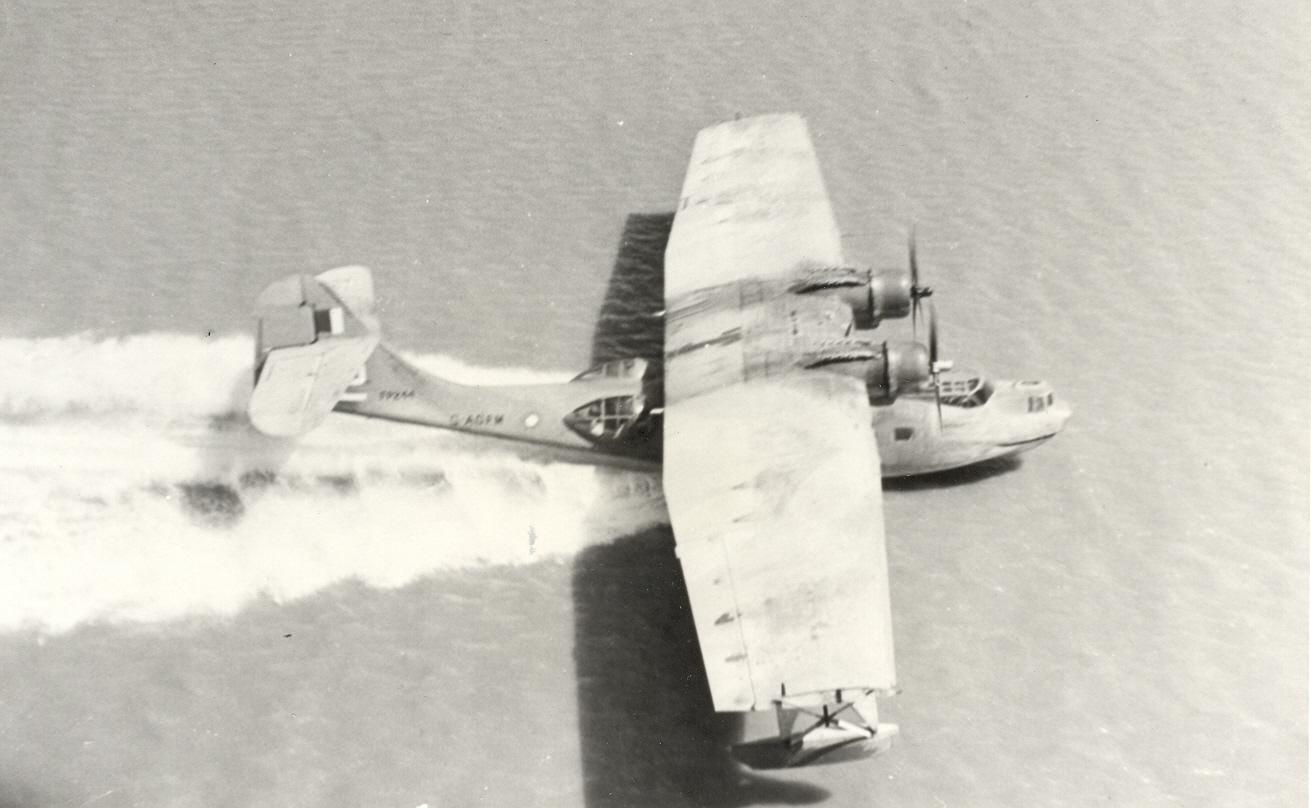
G-AGFM
The Catalina flying boat was designed and built for the US military by the Consolidated Aircraft Co of San Diego, California. (more details)
After the outbreak of war with Germany, the RAF ordered 50 PBY5 model for coastal and maritime defence , and three were transferred to BOAC for a UK-West African passenger service.
AF first flew in PBY5 G-AGDA on 10 Feb 1942 Hythe-Cairo and return.
He flew to West Africa in G-AGFM on 31 May 1942 Foynes-Lisbon-Bathurst-Freetown-Lagos-Freetown-Bathurst-Lisbon-Foynes, arriving on 7 Jan 1943
He did the same Foynes-Lagos-Foynes trip in G-AGDA, arriving back in Foynes on 5 Feb 1943. A few weeks later, on 23 March, G-AGDA crashed in Poole Harbor with at least one casualty and one rescued.
After Japan captured Malaya, Singapore and the Dutch East Indies (Indonesia) in February 1942, a replacement for the Australia-India leg of the joint Imperial Airways/Q.A.N.T.A.S. (QEA) 'kangaroo' service via Singapore wes required.
In March 1943 it was agreed to operate a non-stop Perth-Ceylon service by a joint venture between the RAF, BOAC and Q.A.N.T.A.S , using BOAC's three Catalinas plus three more transferred from the RAF. The non-stop flights took up to 28-32 hours, and could only carry 3 passengers.
In November 1945, under the terms of the US-UK lend-lease agrement, the four Catalina's in West Australia (G-AGFL, G-AGFM, G-AGID and G-AGIE) were scuttled off Rottnest Island, near Fremantle, West Australia. G-AGKS was towed to sea off Sydney and sunk in March 1946.
Chronology courtesy of Graham Wynnum and Ragnar ??, photograph courtesy David Legg, Editor of The Catalina News, The Catalina Society
Liberator

Dorval was transfer base for Lend-Lease aircraft
G-AGCD, G-AGDR, G-AGDS, G-AGHD were transferrec to BOAC in Jan 1942
G-AGDR did Lyneham->Cairo non-stop on 25/26 Jan, but shot down by frioendly fire appraching UK south coast.
In Oct 42 5 more GFN GFO GFP, GFR GFS for West Africa an middle east service
AF first Liberator and first North Atlantic was G-AHYF, Montreal-Gander-London on 15 Sep 1947
{Was he stationed in Montreal by then ???}
All of the BOAC Liberators were returned to the RAF in January of 1945. Seven of them were converted in 1946 as commercial transports. These conversions include
All LB30 LIBERATOR MKII sold to United Kingdom
| Markings | Notes |
|---|---|
| G-AGIP | ->BOAC. Forcelanded 15 m N of Rota, Spain and destroyed by crew 15 Dec 1942 |
| G-AGJP | ->To BOAC 10 Mar 1942 |
| G-AGEL | BOAC 20 Nov 1943. Hit snowdrift on night takeoff and engine caught fire, Gander 27 Dec 1943 |
| G-AGEM | Crashed Charlottetown, PE (Canada) Fatalities: 1 / Occupants: 14 |
| G-AGJP | ? |
| G-AGKT | BOAC->QANTAS 1944 for Perth-Ceylon service |
| G-AGKU | BOAC->QANTAS 1944 for Perth-Ceylon servic |
| G-AGTI | BOAC->QANTAS 1945 as VH-EAI |
| G-AGTJ | BOAC->QANTAS 1945 as VH-EAJ |
| G-AGZH | ->Scottish Airlines |
| G-AGZI | ->BOAC->Scottish Airlines |
| G-AHYB | - |
| G-AHYC | ->BOAC 1944, Bellylanded Heathfield 2 Oct 2 1946 and salvaged |
| G-AHYD | ->BOAC 1 Oct 1944 |
| G-AHYE | ->BOAC 25 Mar 1942 |
| G-AHYF | - |
| G-AHYG | - |
| G-AHYJ | - |
| G-AHZP | ->BOAC. Overshot landing and crashed in sea, Gibraltar 31 Oct 1942 |
| G-AHZR | undercarriage collapsed in heavy landing at night, Fayid 2 Jul 1942 ->BOAC as G-AHZR; ->F-OASS. |
Viking

This is G-AHOS in BEA livery, but AF flew this aircraft on 23 Jul 1947 Aldermaston-Aldermaston training light, with 6 pupil RO's.
Douglas DC 3 Dakota

AF was training at Aldermaston in June and July 1947, using both Viking and DC3 Dakota.
York

The?? York was ???
AF first flew in G-??? York on ??, 194?, G-??? from ?? to ??, to ??
Lancastrian

Lancastrian was a converted Lancaster bomber? Wikipedia ?
The Avro Lancastrian was a British passenger and mail transport aircraft of the 1940s and 1950s developed from the Avro Lancaster bomber. Similar to the Lancaster, but with armament removed and faired over and a streamlined non-glazed metal nose added.
The C.1 model had nine passengers and were supplied to BOAC and Qantas.
(Vol3/p18) 7 Dec Lanc III W4940 Ossigton-Hurn-Rabat-Hurn-Ossigton
AF first flew in a Lancastrian in ??, 194?, G-??? from ?? to ??
Final flight was in ??, 194?, G-??? from ?? to ??
Lockheed L039 Constellation

AF first flew in a Constellation in ??, 1945, G-??? from ?? to ??
Final flight was in ??, 194?, G-??? from ?? to ??
Total: 6
| G-AHEM | Balmoral | First BOAC to fly Atlantic-~~15 Jun 1946 |
| G-AHEJ | Bristol II | - |
| G-AHEK | Berwick II | - |
| G-AHEL | Bangor II | |
| G-AHEN | Baltimore | Crashed at Filton, UK 8 Jan 1951 |
| G-ANTF | Berkeley | |
| G-AKCE | Bedford | ex-TWA->BOAC Mar 1948 |
Boeing B377 Stratocruiser

Caption
BOAC initially bought ?? B377 Startocrusiers - a double deck using fuselage from and wings from ???
AF fist flew in ???., LAP-???. After ?? 19?? until he was made redundant by BOAC, he only flew Startocsruisers to LAP -> New Yor and, this
manufatured from ???
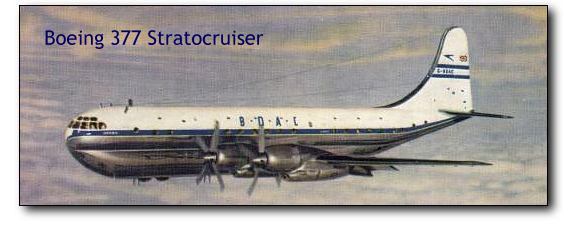
Caption
List of BOAC B377 (16)
10 initially, later 1 from PAA, 6 United 8 configured 50 seat 1st Class 'Monarch', 8 80seat 'coronet' (tourist
by 1957 had 40 passenger with slumberetts beds Developed towards the end of World War II by adapting an enlarged upper fuselage onto the lower fuselage and wings which were essentially the same as the B-50 Superfortress, the high-performance evolution of the B-29 Superfortress bomber. The 377 was larger and longer ranged than the Lockheed Constellation and Douglas DC-7, with nonstop transatlantic range, but the P&W R-4360 Wasp Major engines proved uneconomical, with production ending in 1950. [1] 6600 cubic feet of interior space was provided by the 'inverted-figure-8' doubledeck fuselage design. It offered seating of over 100 passengers, or sleeping berths for up to 28 berthed and five seated passengers. It first flew on July 8, 1947. It had the speed and range to span ocean routes, enabling flying from New York to Hawaii in less than 24 hours.[2] Pressurization (previously introduced on the previous Boeing Stratoliner and also designed into the B-29) allowed breathing sea-level while at an altitude of 15,500 feet (4,700 m). At 25,000 feet (7,600 m), passengers enjoyed a 'cabin altitude' of only 5,500 feet (1,700 m).
http://www.ovi.ch/b377/index.html rom 'Aeroplane Monthly', Reproduced by permission of Aeroplane Monthly magazine June 1996 TONY SPOONER DSO DFC
Flying still had the aura of mysticism around it that inspired poeticallyinclined writers such as Antoine de St Exupéry, who so masterfully expressed it in his book Wind, Sand and Stars. Other flights were sheer hell. The Strat had even slighly less range than the competitive Douglas DC-6s and Lockheed Constellations. Westbound non-stop crossings to Montreal, 200 miles shorter than the flight to New York, were beyond its capabilities, and refuelling stops had to be made. An advertised non-stop service sometimes involved as many as three stops en route, at Prestwick or Shannon to uplift maximum fuel, then at either Gander (frequently covered by early morning fog) or Goose Bay and New York. Iceland was a frequent transit refuelling stop, but, even then, New York might still be beyond range. This meant refuelling again either at Sydney, Nova Scotia, or Moncton, New Brunswick. When Bermuda services were added, the same basic route applied. If Gander was fogged out, as was common, then it would mean having to make a first stop at Keflavik. It required stamina to convince passengers for Bermuda that they were in the right aircraft when we stopped at Iceland en route. As the UK had no Flight Time Regulations until the British Air Line Pilots' Association took the Minister for Aviation (as there then was) to the Industrial Court of Arbitration, it was not too unusual to arrive in New York 16hr or more after departure from London. Once I was 21hr on this route.
| Boeing CN | date | Markings | Name | Disposed to | Date | Pilot | Hours |
|---|---|---|---|---|---|---|---|
| 15974 | 15 Nov 1949 | G-AKGH | Caledonia | TransOcean N137A | 2.8.58 | A. J. Smith | 18,672 |
| 15978 | ? | ?G-AKGI | Caribou | TransOcean N86Q | 19.12.58 | M. A. Wood | 19,091 |
| CN | ? | G-AKGJ | Cambria | Boeing? | 17.1.59 | S. G. Brook | 18,985 |
| CN | ? | G-AKGK | Canopus | ?? | 3.3.59 | M A Kyle | 19,740 |
| CN | ? | G-AKGL | Cabot | ?? | 13.9.58 | J. H. Wickson | 18,535 |
| CN | ? | AKGM | Castor | ?? | 10.3.59 | B. G. Carr | 20,305 |
| 15943 | ? | G-ALSA | Cathay | ?? | ?? | ?? | ?? |
| 15944 | ? | G-ALSB | Champion | ?? | 3.2.59 | C. R. W. Taylor | 19,303 |
| 15945 | ? | G-ALSC | Centaurus | ?? | 18.12.58 | C. Middleton-Stewart | 19,242 |
| 15946 | ? | G-ALSD | Cassiopeia | TransOcean N85Q | 7.9.58 | N. V. Todd | 19,242 |
| 15946 | ? | G-ANTX | Cleopatra (ex UAL N31225) | Boeing? | Date | Pilot | Hours |
| CN | ? | G-ANTY | Coriolanus (ex UAL N31226) | Boeing? | Date | Pilot | Hours |
| CN | ? | G-ANTZ | Cordelio (ex UAL N31227) | Boeing? | Date | Pilot | Hours |
| CN | ? | G-ANUA | Cameronian (ex UAL N31228) | Boeing? | Date | Pilot | Hours |
| CN | ? | G-ANUB | Calypso (ex UAL N31229) | Boeing? | Date | Pilot | Hours |
| CN | ? | G-ANUC | Clio (ex UAL N31231) | Boeing? | Date | Pilot | Hours |
| 15927 | ? | G-ANUM | Clyden (ex PAA N1027V) | 19,247TransOcean N85Q | date | Pilot | 20,119 |
Ref THE A.J. JACKSON PHOTOGRAPHIC COLLECTION Flight Global2 Flight Global1
Article by BOAC pilot Tony Spooner on problems flying the B377
went with Mile sThomas on an inspection tour of US aircradft in May 1948Af flew wit Tony Spooner in G-AGKGK 26 Mar 1952 London-Prestwick-Montreal-Goose Bay, Shannon-London
BOAC Atlantice base was at Dorval , Montreal !base http://www.ovi.ch/b377/articles/speedbird/index.html Parliamentray questions in 1948 about why Dorval, when will it be move dto Filton, and why Filton ??? http://hansard.millbanksystems.com/commons/1948/apr/14/boac-constellation-basefro march 1950 to ??? 185?, flew B3777 Strats London to New York, Boston,Chicago, ,, Montreal, Bemuda, with refuelling variousl ta t Prestwick (Glasgow), Shannion (Ireland) keflavik (Iceland) Sydney (nocva Sctia), GNaneder (??)Goose BAy (???) Nasau, Montego Bay
rear used to flick around in bummpy weater - rear galley unduseable 'first class 'president' section in rear - very angy customers ! MAjor problems with propllers, and oil consumpriton enfnies very complicated, and expensive to maintain. Cylinder heads had to be replaced frquentyly replace,new heads e constant replacement of 112 spark plugs, exhaust valves and oil pumps. I Planes would often arrive with one or even two engines not working, propllers feathered severla propellos broke off in miode flight, several tearuing into the fuselage and kiling pax and cabin crew Boading doeos faile, with passngers and cres sucked out IMPERIAL AIRWAYS LTD. as at 1936| No. 1 OPERATING DIVISION | ||
|---|---|---|
| G-AAGW | Westland Wessex | |
| G-ABKY | Vickers Vellox | |
| G-ACHI | Westland Wessex | |
| G-ACJJ | Scylla | |
| G-ACJK | Syrinx | |
| G-ACOX | Boulton&Paul | |
| G-ACWD | DH86 | |
| C-ADFF | DH86 | |
| G-ADUE | DH86 | |
| G-ADUF | DH86 | |
| G-ADUG | DH86 | |
| G-ADUH | DH86 | |
| G-ADUI | DH86 | |
| G-AEAP | DH86 | |
| No. 2 OPERATING DIVISION | ||
| AG-AAGX | ? | |
| G-ACJJ | ? | |
| G-ACJK | ? | |
| G-ACOX | ? | |
| G-ACRM | ? | |
| G-ACRN | ? | |
| G-ACWD | ? | |
| C-ADFF | ? | |
| G-ADUE | ? | |
| G-ADUF | ? | |
| G-ADUG | ? | |
| G-ADUH | ? | |
| G-ADUI | ? | |
| G-AEAP | ? | |
| V-TAEF | Arethusa | ? |
| V-TAEG | Aurora | ? |
| No. 4 OPERATING DIVISION | ||
| G-ABTG Amalthea | ? | |
| G-ABTH Andromeda | ? | |
| G-ABTJ Artemis | ? | |
| G-ABTL Astraea | ? | |